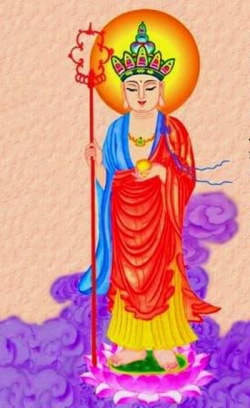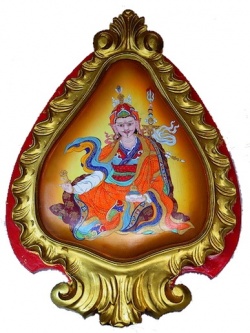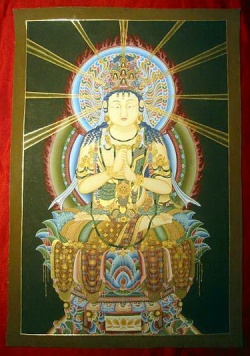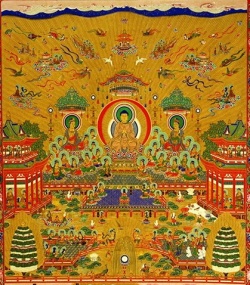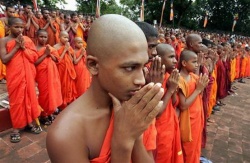Difference between revisions of "The Tree of Enlightenment: An Introduction to the Major Traditions of Buddhism - Chapter Twenty-Three: Philosophical and Religious Foundations"
(Created page with "{{DisplayImages|3935|1546|2972|3635|3499|2616|1751|626|3214|2273}} {{Centre|<big><big>The Tree of Enlightenment<br/> An Introduction to the Major Traditions of Buddhism</big><...") |
m (Text replacement - "first stage" to "first stage") |
||
| (2 intermediate revisions by 2 users not shown) | |||
| Line 5: | Line 5: | ||
==Part Three: The [[Vajrayana]]== | ==Part Three: The [[Vajrayana]]== | ||
| − | ===Chapter Twenty-Three <br/>[[Philosophical]] and [[Religious]] Foundations=== | + | ===[[Chapter]] Twenty-Three <br/>[[Philosophical]] and [[Religious]] Foundations=== |
It is important to examine the [[philosophical]] and [[religious]] foundations of the [[Vajrayana]] so as to better understand how it fits into the [[Buddhist tradition]] as a whole. As we look at the [[Vajrayana tradition]] in more detail, we will find that it incorporates a number of important [[Mahayana]] [[ideas]]. Three [[religious]] and [[philosophical]] [[ideas]] that are prevalent in the [[Mahayana]] play a [[vital]] role in the [[Vajrayana]] as well. These are the [[ideas]] of (1) [[emptiness]], (2) [[Mind Only]], and (3) expedient or [[skillful means]]. | It is important to examine the [[philosophical]] and [[religious]] foundations of the [[Vajrayana]] so as to better understand how it fits into the [[Buddhist tradition]] as a whole. As we look at the [[Vajrayana tradition]] in more detail, we will find that it incorporates a number of important [[Mahayana]] [[ideas]]. Three [[religious]] and [[philosophical]] [[ideas]] that are prevalent in the [[Mahayana]] play a [[vital]] role in the [[Vajrayana]] as well. These are the [[ideas]] of (1) [[emptiness]], (2) [[Mind Only]], and (3) expedient or [[skillful means]]. | ||
| − | In Chapter 22, I had occasion to refer to the fact that the [[Tibetan tradition]] regards [[Nagarjuna]] and [[Asanga]] as the founders of the [[Vajrayana path]]. In addition to the [[Vajrayana]] [[elements]] contained in their {{Wiki|biographies}}, as discussed in Chapter 22, there is an equally significant way [[Nagarjuna]] and [[Asanga]] can be considered [[Vajrayana's]] founding fathers--namely, because of their advocacy and explanation of the [[ideas]] of [[emptiness]] and the primacy of [[consciousness]] (or [[Mind Only]]). A number of [[Vajrayana]] works in the [[Tibetan canon]] are attributed to [[Nagarjuna]] and [[Asanga]], though this attribution is disputed by {{Wiki|modern}} [[scholars]]. Whether or not [[Nagarjuna]] and [[Asanga]] actually wrote specifically [[Vajrayana]] works, it is quite clear that, without the [[ideas]] they put forward, the [[Vajrayana]] would be unintelligible, and very likely impossible as well. | + | In [[Chapter]] 22, I had [[occasion]] to refer to the fact that the [[Tibetan tradition]] regards [[Nagarjuna]] and [[Asanga]] as the founders of the [[Vajrayana path]]. In addition to the [[Vajrayana]] [[elements]] contained in their {{Wiki|biographies}}, as discussed in [[Chapter]] 22, there is an equally significant way [[Nagarjuna]] and [[Asanga]] can be considered [[Vajrayana's]] founding fathers--namely, because of their advocacy and explanation of the [[ideas]] of [[emptiness]] and the primacy of [[consciousness]] (or [[Mind Only]]). A number of [[Vajrayana]] works in the [[Tibetan canon]] are attributed to [[Nagarjuna]] and [[Asanga]], though this attribution is disputed by {{Wiki|modern}} [[scholars]]. Whether or not [[Nagarjuna]] and [[Asanga]] actually wrote specifically [[Vajrayana]] works, it is quite clear that, without the [[ideas]] they put forward, the [[Vajrayana]] would be unintelligible, and very likely impossible as well. |
| − | Let us look first at the [[idea]] of [[emptiness]], which is so [[characteristic]] of the writings of [[Nagarjuna]]. In Chapter 22, I referred to a situation in which [[Nagarjuna]] is said to have [[transformed]] base [[objects]] into {{Wiki|gold}}. This can be seen as a {{Wiki|metaphor}} for the main project with which the [[Vajrayana]] is concerned: [[transforming]] common [[experience]] into the [[experience]] of [[enlightenment]]. If we look at this analogy of [[alchemy]], we see that, for [[transformation]] to be possible, the base [[object]] cannot have any real, [[permanent]] [[nature]] of its own. For instance, if a piece of coal were to have an [[unchanging]], intrinsic [[nature]], it could never be changed into anything else. Yet we know that a piece of coal can, under certain [[conditions]], become a [[diamond]]. | + | Let us look first at the [[idea]] of [[emptiness]], which is so [[characteristic]] of the writings of [[Nagarjuna]]. In [[Chapter]] 22, I referred to a situation in which [[Nagarjuna]] is said to have [[transformed]] base [[objects]] into {{Wiki|gold}}. This can be seen as a {{Wiki|metaphor}} for the main project with which the [[Vajrayana]] is concerned: [[transforming]] common [[experience]] into the [[experience]] of [[enlightenment]]. If we look at this analogy of [[alchemy]], we see that, for [[transformation]] to be possible, the base [[object]] cannot have any real, [[permanent]] [[nature]] of its [[own]]. For instance, if a piece of coal were to have an [[unchanging]], intrinsic [[nature]], it could never be changed into anything else. Yet we know that a piece of coal can, under certain [[conditions]], become a [[diamond]]. |
The [[idea]] of an [[unchanging]], {{Wiki|independent}} [[character]] is expressed in [[Sanskrit]] by the term [[svabhava]], which means '[[own-being]]' or 'self-existence.' The absence of [[own-being]] is [[nihsvabhava]], which is {{Wiki|synonymous}} with [[emptiness]]. [[Emptiness]] is, of course, not [[nothingness]]. It is, rather, a kind of [[openness]], a situation in which [[phenomena]] [[exist]] dependent on [[causes and conditions]]. | The [[idea]] of an [[unchanging]], {{Wiki|independent}} [[character]] is expressed in [[Sanskrit]] by the term [[svabhava]], which means '[[own-being]]' or 'self-existence.' The absence of [[own-being]] is [[nihsvabhava]], which is {{Wiki|synonymous}} with [[emptiness]]. [[Emptiness]] is, of course, not [[nothingness]]. It is, rather, a kind of [[openness]], a situation in which [[phenomena]] [[exist]] dependent on [[causes and conditions]]. | ||
| Line 19: | Line 19: | ||
In the [[Mahayana]], where this [[idea]] is elaborated at great length, all [[phenomena]] are likened to a [[magical]] [[illusion]]. An [[illusory]] [[elephant]], for example, appears dependent on some basis, like a hill of [[earth]] or a piece of [[wood]], and is brought into being by a [[Wikipedia:Magician(paranormal)|magician]] using certain [[magical]] {{Wiki|spells}} and so forth. Thus [[illusory]] [[appearances]] come about dependent on certain [[causes and conditions]]. Similarly, all [[phenomena]] [[exist]] dependent on certain [[causes and conditions]]. It is because of this [[dependence]], this [[emptiness]], that [[transformation]] is possible. | In the [[Mahayana]], where this [[idea]] is elaborated at great length, all [[phenomena]] are likened to a [[magical]] [[illusion]]. An [[illusory]] [[elephant]], for example, appears dependent on some basis, like a hill of [[earth]] or a piece of [[wood]], and is brought into being by a [[Wikipedia:Magician(paranormal)|magician]] using certain [[magical]] {{Wiki|spells}} and so forth. Thus [[illusory]] [[appearances]] come about dependent on certain [[causes and conditions]]. Similarly, all [[phenomena]] [[exist]] dependent on certain [[causes and conditions]]. It is because of this [[dependence]], this [[emptiness]], that [[transformation]] is possible. | ||
| − | [[Nagarjuna]] says that if there were any [[own-being]], [[transformation]] by means of the [[path of liberation]] would be impossible. In other words, if that lump of coal we referred to a moment ago had an unchangeable [[nature]], it could never become a [[diamond]]. Similarly, if each and every one of us had an [[own-being]] or [[permanent]] [[existence]] as ordinary, afflicted [[sentient]] beings--if this were our identity--then no {{Wiki|matter}} how much we practiced the [[Dharma]], we could never become [[enlightened]]. It is because we are [[subject]] to the [[afflictions]] ([[ignorance]], [[attachment]], and [[aversion]]) that we have the [[nature]] of ordinary [[sentient beings]]. But if we replace [[ignorance]] with [[wisdom]], [[attachment]] with lack of [[attachment]], and [[aversion]] with [[love]] and [[compassion]], we can change these [[conditions]]. By changing these [[conditions]], we can change the [[nature]] of our being and become [[Buddhas]]. [[Emptiness]] is therefore absolutely necessary to allow for [[transformation]] from the [[condition]] of [[samsara]] to the [[liberation]] of [[nirvana]]. | + | [[Nagarjuna]] says that if there were any [[own-being]], [[transformation]] by means of the [[path of liberation]] would be impossible. In other words, if that lump of coal we referred to a [[moment]] ago had an unchangeable [[nature]], it could never become a [[diamond]]. Similarly, if each and every one of us had an [[own-being]] or [[permanent]] [[existence]] as ordinary, afflicted [[sentient]] beings--if this were our identity--then no {{Wiki|matter}} how much we practiced the [[Dharma]], we could never become [[enlightened]]. It is because we are [[subject]] to the [[afflictions]] ([[ignorance]], [[attachment]], and [[aversion]]) that we have the [[nature]] of ordinary [[sentient beings]]. But if we replace [[ignorance]] with [[wisdom]], [[attachment]] with lack of [[attachment]], and [[aversion]] with [[love]] and [[compassion]], we can change these [[conditions]]. By changing these [[conditions]], we can change the [[nature]] of our being and become [[Buddhas]]. [[Emptiness]] is therefore absolutely necessary to allow for [[transformation]] from the [[condition]] of [[samsara]] to the [[liberation]] of [[nirvana]]. |
Let us look now at the second [[idea]], that of the role of the [[mind]] in [[experience]]. Here [[Asanga]] and his younger brother [[Vasubandhu]] made two general points: (a) that [[objects]] have no {{Wiki|stable}} or fixed [[form]] of [[appearance]], and (b) that [[objects]] appear even without an external {{Wiki|stimulus}}. | Let us look now at the second [[idea]], that of the role of the [[mind]] in [[experience]]. Here [[Asanga]] and his younger brother [[Vasubandhu]] made two general points: (a) that [[objects]] have no {{Wiki|stable}} or fixed [[form]] of [[appearance]], and (b) that [[objects]] appear even without an external {{Wiki|stimulus}}. | ||
| Line 25: | Line 25: | ||
Like other major {{Wiki|tenets}} of the [[Mahayana]] and [[Vajrayana]], these two points are not absent from the [[Theravada tradition]]. The first is evident in a number of [[Buddhist texts]]. For example, the incident involving the Elder [[Tissa]] is well known within [[Theravada]] circles: when asked whether he had seen a woman on the road, [[Tissa]] replied that he did not know whether it was a man or a woman, but only that he had seen a heap of {{Wiki|bones}} going up the road. This shows that [[objects]] have no {{Wiki|stable}} or fixed [[form]] of [[appearance]]; what appears as an attractive woman to one man appears as a heap of {{Wiki|bones}} to another. | Like other major {{Wiki|tenets}} of the [[Mahayana]] and [[Vajrayana]], these two points are not absent from the [[Theravada tradition]]. The first is evident in a number of [[Buddhist texts]]. For example, the incident involving the Elder [[Tissa]] is well known within [[Theravada]] circles: when asked whether he had seen a woman on the road, [[Tissa]] replied that he did not know whether it was a man or a woman, but only that he had seen a heap of {{Wiki|bones}} going up the road. This shows that [[objects]] have no {{Wiki|stable}} or fixed [[form]] of [[appearance]]; what appears as an attractive woman to one man appears as a heap of {{Wiki|bones}} to another. | ||
| − | The [[Mahayana tradition]] elaborates on this by recourse to the [[experience]] of a number of altered states of [[consciousness]]. For example, one [[feels]] the [[earth]] move, or that one has enormous power, when one has imbibed too much [[alcohol]]. Similarly, under the influence of {{Wiki|psychedelic}} {{Wiki|substances}}, one's [[perception]] of [[objects]] is different. In his Twenty Verses on [[Cognition]] Only, [[Vasubandhu]] illustrates this with reference to the [[experience]] of the [[beings]] of the [[six realms]] (see also Chapter 19). There, he {{Wiki|spells}} out the diverse ways [[objects]] appear depending on the subjective [[conditions]] of the {{Wiki|perceiver}}, concluding that [[objects]] appear in different shapes and [[forms]] to different [[sentient beings]] according to their [[karmic]] [[condition]]. | + | The [[Mahayana tradition]] elaborates on this by recourse to the [[experience]] of a number of altered states of [[consciousness]]. For example, one [[feels]] the [[earth]] move, or that one has enormous power, when one has imbibed too much [[alcohol]]. Similarly, under the influence of {{Wiki|psychedelic}} {{Wiki|substances}}, one's [[perception]] of [[objects]] is different. In his Twenty Verses on [[Cognition]] Only, [[Vasubandhu]] illustrates this with reference to the [[experience]] of the [[beings]] of the [[six realms]] (see also [[Chapter]] 19). There, he {{Wiki|spells}} out the diverse ways [[objects]] appear depending on the [[subjective]] [[conditions]] of the {{Wiki|perceiver}}, concluding that [[objects]] appear in different shapes and [[forms]] to different [[sentient beings]] according to their [[karmic]] [[condition]]. |
| − | The second point, that [[objects]] appear even without an external {{Wiki|stimulus}}, is also found in the early [[Theravada tradition]]. For example, in Buddhaghosha's explanation of the three stages of [[concentration]] (preliminary, proximate, and accomplished), the image of [[meditation]] becomes internalized at the proximate stage. If a [[meditator]] uses, say, a blue disk at the | + | The second point, that [[objects]] appear even without an external {{Wiki|stimulus}}, is also found in the early [[Theravada tradition]]. For example, in Buddhaghosha's explanation of the three stages of [[concentration]] (preliminary, proximate, and accomplished), the image of [[meditation]] becomes internalized at the proximate stage. If a [[meditator]] uses, say, a blue disk at the first stage, at the second stage that disk becomes internalized and he now [[meditates]] on a [[mental]] replica of it. Consequently, whereas on the first stage he uses a [[physical object]] as his [[object]] of [[meditation]], on the second stage of [[concentration]] he no longer needs that external support. The [[object]] now appears to him without the need of an external {{Wiki|stimulus}}. We can also see this in [[dreams]], where the dreamer [[experiences]] [[objects]] without any external {{Wiki|stimuli}}. |
| − | [[Vasubandhu]] adds to this the case of the wardens of the [[hell realms]]. If these wardens were [[reborn]] in the [[hells]] because of their own [[karma]], they, too, would [[experience]] the [[sufferings]] there. But since wardens are in the [[hells]] simply to torment [[hell beings]], [[Vasubandhu]] suggests that they are mere creations of the [[minds]] of the [[hell beings]] themselves. In other words, because of their [[unwholesome]] [[karma]], [[hell beings]] project images of wardens who then proceed to torment them. | + | [[Vasubandhu]] adds to this the case of the wardens of the [[hell realms]]. If these wardens were [[reborn]] in the [[hells]] because of their [[own]] [[karma]], they, too, would [[experience]] the [[sufferings]] there. But since wardens are in the [[hells]] simply to torment [[hell beings]], [[Vasubandhu]] suggests that they are mere creations of the [[minds]] of the [[hell beings]] themselves. In other words, because of their [[unwholesome]] [[karma]], [[hell beings]] project images of wardens who then proceed to torment them. |
In all these cases--the [[experiences]] of [[meditation]], of [[dreaming]], and of [[hell]] beings--objects appear without any external {{Wiki|stimulus}}. This is why it is said that, just as a painter might paint a portrait of the {{Wiki|demon}} and then be terrified by it, so [[unenlightened beings]] paint a picture of the [[six realms of samsara]] and then are tormented and terrified by that picture. Through the power of our [[minds]], we create the [[six realms of existence]] and then circle in them endlessly. We are able to create these [[six realms]] precisely because there is no [[own-being]]. | In all these cases--the [[experiences]] of [[meditation]], of [[dreaming]], and of [[hell]] beings--objects appear without any external {{Wiki|stimulus}}. This is why it is said that, just as a painter might paint a portrait of the {{Wiki|demon}} and then be terrified by it, so [[unenlightened beings]] paint a picture of the [[six realms of samsara]] and then are tormented and terrified by that picture. Through the power of our [[minds]], we create the [[six realms of existence]] and then circle in them endlessly. We are able to create these [[six realms]] precisely because there is no [[own-being]]. | ||
| Line 35: | Line 35: | ||
These first two ideas--the [[idea]] of [[emptiness]] and the [[idea]] of the role of the [[mind]] in creating experience--go together. [[Objects]] have no {{Wiki|independent}} [[existence]]. Their [[existence]] is [[relative]] to [[causes]] and conditions--most importantly, the [[mental]] [[causes and conditions]] of [[ignorance]], [[attachment]], [[aversion]], [[greed]], [[anger]], [[jealousy]], and the like. Because of these [[mental]] [[conditions]], and because of the fact that [[phenomena]] are [[empty]], the [[mind]] constructs and creates [[experience]] in a particular [[form]], in the [[form]] of the [[suffering]] of the [[six realms]]. | These first two ideas--the [[idea]] of [[emptiness]] and the [[idea]] of the role of the [[mind]] in creating experience--go together. [[Objects]] have no {{Wiki|independent}} [[existence]]. Their [[existence]] is [[relative]] to [[causes]] and conditions--most importantly, the [[mental]] [[causes and conditions]] of [[ignorance]], [[attachment]], [[aversion]], [[greed]], [[anger]], [[jealousy]], and the like. Because of these [[mental]] [[conditions]], and because of the fact that [[phenomena]] are [[empty]], the [[mind]] constructs and creates [[experience]] in a particular [[form]], in the [[form]] of the [[suffering]] of the [[six realms]]. | ||
| − | Just as the [[mind]] can work {{Wiki|unconsciously}} and automatically to create the [[experience]] of [[suffering]] in the [[six realms]], so the [[mind]] can be made to work deliberately and [[consciously]] to bring about a change in that [[experience]], to bring about the [[experience]] of [[liberation]]. This is quite clear in the example of the [[experience]] of [[meditation]] that we considered a moment ago. Ordinarily, the [[mind]] functions {{Wiki|unconsciously}} and automatically to create [[experience]]. We respond to an [[object]], such as the [[form]] of a woman, because of our habitual {{Wiki|conditioning}}, because we are [[subject]] to [[desire]] and [[ignorance]]. In [[meditation]] we train the [[mind]] to [[function]] in a chosen, decisive way to change our [[experience]]. Through the [[experience]] of [[meditation]], we can change our [[perception]] of the [[object]] in the same way the Elder [[Tissa]] changed his [[perception]] so that he was able to see the [[form]] of a woman as only a heap of {{Wiki|bones}}. | + | Just as the [[mind]] can work {{Wiki|unconsciously}} and automatically to create the [[experience]] of [[suffering]] in the [[six realms]], so the [[mind]] can be made to work deliberately and [[consciously]] to bring about a change in that [[experience]], to bring about the [[experience]] of [[liberation]]. This is quite clear in the example of the [[experience]] of [[meditation]] that we considered a [[moment]] ago. Ordinarily, the [[mind]] functions {{Wiki|unconsciously}} and automatically to create [[experience]]. We respond to an [[object]], such as the [[form]] of a woman, because of our habitual {{Wiki|conditioning}}, because we are [[subject]] to [[desire]] and [[ignorance]]. In [[meditation]] we train the [[mind]] to [[function]] in a chosen, decisive way to change our [[experience]]. Through the [[experience]] of [[meditation]], we can change our [[perception]] of the [[object]] in the same way the Elder [[Tissa]] changed his [[perception]] so that he was able to see the [[form]] of a woman as only a heap of {{Wiki|bones}}. |
| − | Again, we ordinarily {{Wiki|perceive}} different colors automatically, in an undirected and unspecified way. Through [[meditation]], we can alter that situation so that we can, at will, [[visualize]] and create a particular patch of {{Wiki|color}} within our [[mental]] [[experience]]. The [[idea]] of [[emptiness]] and the [[idea]] of the creative power of the [[mind]] are clearly {{Wiki|present}} in the structure of the [[Vajrayana]] techniques of [[meditation]], which we will be looking at in greater detail in Chapter 29. [[Emptiness]] and the creative power of the [[mind]] together give us the ability and the [[Wikipedia:scientific method|methodology]] needed to [[transform]] our [[experience]]. We can [[transform]] our [[experience]] because nothing has any [[nature]] of its own, and the way we [[transform]] it is through using the power of our [[minds]] to create and determine the way we [[experience]] [[objects]]. | + | Again, we ordinarily {{Wiki|perceive}} different colors automatically, in an undirected and unspecified way. Through [[meditation]], we can alter that situation so that we can, at will, [[visualize]] and create a particular patch of {{Wiki|color}} within our [[mental]] [[experience]]. The [[idea]] of [[emptiness]] and the [[idea]] of the creative power of the [[mind]] are clearly {{Wiki|present}} in the {{Wiki|structure}} of the [[Vajrayana]] techniques of [[meditation]], which we will be looking at in greater detail in [[Chapter]] 29. [[Emptiness]] and the creative power of the [[mind]] together give us the ability and the [[Wikipedia:scientific method|methodology]] needed to [[transform]] our [[experience]]. We can [[transform]] our [[experience]] because nothing has any [[nature]] of its [[own]], and the way we [[transform]] it is through using the power of our [[minds]] to create and determine the way we [[experience]] [[objects]]. |
| − | As mentioned in Chapter 22, the [[Vajrayana]] is one with the [[Mahayana]] both in its starting point and in its goal. The fundamental [[idea]] in the [[Mahayana tradition]] is the [[enlightenment]] [[thought]] or [[mind]] ([[bodhichitta]], the resolve to achieve [[enlightenment]] for the sake of all [[sentient beings]]), and the fruit of this resolve is the [[attainment of Buddhahood]], with its [[transcendental]] [[dimension]] and its [[phenomenal]] [[dimension]]. The [[phenomenal]] [[dimension]] is an expression of the [[Buddha's]] [[great compassion]], which [[manifests]] itself in [[skillful]] means--the third [[idea]] prevalent in the [[Mahayana]] and crucial to the [[Vajrayana]] as well. | + | As mentioned in [[Chapter]] 22, the [[Vajrayana]] is one with the [[Mahayana]] both in its starting point and in its goal. The fundamental [[idea]] in the [[Mahayana tradition]] is the [[enlightenment]] [[thought]] or [[mind]] ([[bodhichitta]], the resolve to achieve [[enlightenment]] for the sake of all [[sentient beings]]), and the fruit of this resolve is the [[attainment of Buddhahood]], with its [[transcendental]] [[dimension]] and its [[phenomenal]] [[dimension]]. The [[phenomenal]] [[dimension]] is an expression of the [[Buddha's]] [[great compassion]], which [[manifests]] itself in [[skillful]] means--the third [[idea]] prevalent in the [[Mahayana]] and crucial to the [[Vajrayana]] as well. |
| − | [[Skillful means]] is the ability to reach all [[sentient beings]] at their own levels. In many [[Mahayana sutras]], this is explained with the help of analogies, such as the [[parable]] of the three carts and that of rainfall and the light of the {{Wiki|sun}} and [[moon]] in the [[Lotus Sutra]] (see Chapter 15) The [[phenomenal]] [[dimension]] of the [[Buddha]] appears to all [[sentient beings]] according to their particular needs and {{Wiki|abilities}}. It [[manifests]] itself in a variety of [[forms]], such as that of the beautiful maiden whom the [[Buddha]] [[caused]] to appear for the sake of Kshema (see Chapter 22). In many [[Mahayana]] [[discourses]] and treatises, the [[Buddha]] [[manifests]] himself in the [[form]] of [[ordinary people]] or [[gods]] in order to assist [[sentient beings]] along the [[path to liberation]]. | + | [[Skillful means]] is the ability to reach all [[sentient beings]] at their [[own]] levels. In many [[Mahayana sutras]], this is explained with the help of analogies, such as the [[parable]] of the three carts and that of rainfall and the {{Wiki|light}} of the {{Wiki|sun}} and [[moon]] in the [[Lotus Sutra]] (see [[Chapter]] 15) The [[phenomenal]] [[dimension]] of the [[Buddha]] appears to all [[sentient beings]] according to their particular needs and {{Wiki|abilities}}. It [[manifests]] itself in a variety of [[forms]], such as that of the beautiful maiden whom the [[Buddha]] [[caused]] to appear for the sake of Kshema (see [[Chapter]] 22). In many [[Mahayana]] [[discourses]] and treatises, the [[Buddha]] [[manifests]] himself in the [[form]] of [[ordinary people]] or [[gods]] in order to assist [[sentient beings]] along the [[path to liberation]]. |
It is in this way, too, that the [[Buddha]] [[manifests]] himself in the special [[forms]] of the [[deities]] of the [[Vajrayana]] {{Wiki|pantheon}} according to the needs and propensities of [[sentient beings]]. For example, in the case of the five [[celestial]] [[Buddhas]], the [[Buddha]] [[manifests]] himself in five special [[forms]] that correspond to the particular [[karmic]] propensities of [[sentient beings]]. Thus he [[manifests]] as the [[Buddha Vairochana]] especially for [[sentient beings]] whose primary [[affliction]] is [[ignorance]], while it is [[Akshobhya]] who appears to those whose primary [[affliction]] is [[ill-will]] and [[Amitabha]] to those whose primary [[affliction]] is [[attachment]]. The [[Buddha]] [[manifests]] himself in these different [[forms]] to best assist different [[sentient beings]] with particular [[karmic]] problems. | It is in this way, too, that the [[Buddha]] [[manifests]] himself in the special [[forms]] of the [[deities]] of the [[Vajrayana]] {{Wiki|pantheon}} according to the needs and propensities of [[sentient beings]]. For example, in the case of the five [[celestial]] [[Buddhas]], the [[Buddha]] [[manifests]] himself in five special [[forms]] that correspond to the particular [[karmic]] propensities of [[sentient beings]]. Thus he [[manifests]] as the [[Buddha Vairochana]] especially for [[sentient beings]] whose primary [[affliction]] is [[ignorance]], while it is [[Akshobhya]] who appears to those whose primary [[affliction]] is [[ill-will]] and [[Amitabha]] to those whose primary [[affliction]] is [[attachment]]. The [[Buddha]] [[manifests]] himself in these different [[forms]] to best assist different [[sentient beings]] with particular [[karmic]] problems. | ||
| − | These [[manifestations]] of the [[Buddha]] interact with [[sentient beings]] to bring about their [[liberation]]. There is a kind of [[interdependence]] between the [[manifestations]] of the [[Buddha]] (in the [[forms]] of the [[Heavenly]] [[Buddhas]] and of [[deities]] of the [[Vajrayana]] {{Wiki|pantheon}}) and the [[development]] of [[sentient beings]] through the practice of [[meditation]]. To illustrate this, letme return to the story of [[Asanga]] and the [[future Buddha]] [[Maitreya]]. [[Asanga]] [[meditated]] for twelve years before he was able to {{Wiki|perceive}} [[Maitreya]]. [[Maitreya]] was with him all along, but [[Asanga]] had to develop his [[vision]] so that he was in a position to [[experience]] [[Maitreya]] directly. In the same way, the [[manifestations]] of the [[Buddha]] are around us all the [[time]], but to {{Wiki|perceive}} them directly we must develop our [[minds]] through [[meditation]], through the careful [[purification]] of our [[beings]]. This [[purification]] of the [[mind]] may be likened to the process of tuning a television set to receive a particular [[transmission]]. The [[transmission]] is there all along, but unless and until the receiver is tuned to the correct frequency to receive it, the picture cannot be seen. | + | These [[manifestations]] of the [[Buddha]] interact with [[sentient beings]] to bring about their [[liberation]]. There is a kind of [[interdependence]] between the [[manifestations]] of the [[Buddha]] (in the [[forms]] of the [[Heavenly]] [[Buddhas]] and of [[deities]] of the [[Vajrayana]] {{Wiki|pantheon}}) and the [[development]] of [[sentient beings]] through the [[practice]] of [[meditation]]. To illustrate this, letme return to the story of [[Asanga]] and the [[future Buddha]] [[Maitreya]]. [[Asanga]] [[meditated]] for twelve years before he was able to {{Wiki|perceive}} [[Maitreya]]. [[Maitreya]] was with him all along, but [[Asanga]] had to develop his [[vision]] so that he was in a position to [[experience]] [[Maitreya]] directly. In the same way, the [[manifestations]] of the [[Buddha]] are around us all the [[time]], but to {{Wiki|perceive}} them directly we must develop our [[minds]] through [[meditation]], through the careful [[purification]] of our [[beings]]. This [[purification]] of the [[mind]] may be likened to the process of tuning a television set to receive a particular [[transmission]]. The [[transmission]] is there all along, but unless and until the receiver is tuned to the correct frequency to receive it, the picture cannot be seen. |
If we remember these three principles--the [[principle]] of [[emptiness]], the [[principle]] of the power of the [[mind]] to determine the [[nature]] of our [[experience]], and the [[principle]] of [[skillful means]], we will be able to understand how the [[Vajrayana path]] can work. We will also be able to understand the diversity of the [[forms]] and images that the [[Vajrayana]] uses to expedite the process of [[transformation]]. | If we remember these three principles--the [[principle]] of [[emptiness]], the [[principle]] of the power of the [[mind]] to determine the [[nature]] of our [[experience]], and the [[principle]] of [[skillful means]], we will be able to understand how the [[Vajrayana path]] can work. We will also be able to understand the diversity of the [[forms]] and images that the [[Vajrayana]] uses to expedite the process of [[transformation]]. | ||
Latest revision as of 06:32, 9 February 2016
The Tree of Enlightenment
An Introduction to the Major Traditions of Buddhism
Peter Della Santina
Part Three: The Vajrayana
Chapter Twenty-Three
Philosophical and Religious Foundations
It is important to examine the philosophical and religious foundations of the Vajrayana so as to better understand how it fits into the Buddhist tradition as a whole. As we look at the Vajrayana tradition in more detail, we will find that it incorporates a number of important Mahayana ideas. Three religious and philosophical ideas that are prevalent in the Mahayana play a vital role in the Vajrayana as well. These are the ideas of (1) emptiness, (2) Mind Only, and (3) expedient or skillful means.
In Chapter 22, I had occasion to refer to the fact that the Tibetan tradition regards Nagarjuna and Asanga as the founders of the Vajrayana path. In addition to the Vajrayana elements contained in their biographies, as discussed in Chapter 22, there is an equally significant way Nagarjuna and Asanga can be considered Vajrayana's founding fathers--namely, because of their advocacy and explanation of the ideas of emptiness and the primacy of consciousness (or Mind Only). A number of Vajrayana works in the Tibetan canon are attributed to Nagarjuna and Asanga, though this attribution is disputed by modern scholars. Whether or not Nagarjuna and Asanga actually wrote specifically Vajrayana works, it is quite clear that, without the ideas they put forward, the Vajrayana would be unintelligible, and very likely impossible as well.
Let us look first at the idea of emptiness, which is so characteristic of the writings of Nagarjuna. In Chapter 22, I referred to a situation in which Nagarjuna is said to have transformed base objects into gold. This can be seen as a metaphor for the main project with which the Vajrayana is concerned: transforming common experience into the experience of enlightenment. If we look at this analogy of alchemy, we see that, for transformation to be possible, the base object cannot have any real, permanent nature of its own. For instance, if a piece of coal were to have an unchanging, intrinsic nature, it could never be changed into anything else. Yet we know that a piece of coal can, under certain conditions, become a diamond.
The idea of an unchanging, independent character is expressed in Sanskrit by the term svabhava, which means 'own-being' or 'self-existence.' The absence of own-being is nihsvabhava, which is synonymous with emptiness. Emptiness is, of course, not nothingness. It is, rather, a kind of openness, a situation in which phenomena exist dependent on causes and conditions.
Although this idea of emptiness is most commonly associated with Nagarjuna and the Middle Way school, like the other important doctrines of the Mahayana, it also exists in the Theravada tradition. For example, according to the Theravada canon, the Buddha likened all phenomena to the flame of an oil lamp, which exists dependent on the oil and the wick. The flame is nothing in itself. Similarly, all phenomena depend on causes and conditions.
In the Mahayana, where this idea is elaborated at great length, all phenomena are likened to a magical illusion. An illusory elephant, for example, appears dependent on some basis, like a hill of earth or a piece of wood, and is brought into being by a magician using certain magical spells and so forth. Thus illusory appearances come about dependent on certain causes and conditions. Similarly, all phenomena exist dependent on certain causes and conditions. It is because of this dependence, this emptiness, that transformation is possible.
Nagarjuna says that if there were any own-being, transformation by means of the path of liberation would be impossible. In other words, if that lump of coal we referred to a moment ago had an unchangeable nature, it could never become a diamond. Similarly, if each and every one of us had an own-being or permanent existence as ordinary, afflicted sentient beings--if this were our identity--then no matter how much we practiced the Dharma, we could never become enlightened. It is because we are subject to the afflictions (ignorance, attachment, and aversion) that we have the nature of ordinary sentient beings. But if we replace ignorance with wisdom, attachment with lack of attachment, and aversion with love and compassion, we can change these conditions. By changing these conditions, we can change the nature of our being and become Buddhas. Emptiness is therefore absolutely necessary to allow for transformation from the condition of samsara to the liberation of nirvana.
Let us look now at the second idea, that of the role of the mind in experience. Here Asanga and his younger brother Vasubandhu made two general points: (a) that objects have no stable or fixed form of appearance, and (b) that objects appear even without an external stimulus.
Like other major tenets of the Mahayana and Vajrayana, these two points are not absent from the Theravada tradition. The first is evident in a number of Buddhist texts. For example, the incident involving the Elder Tissa is well known within Theravada circles: when asked whether he had seen a woman on the road, Tissa replied that he did not know whether it was a man or a woman, but only that he had seen a heap of bones going up the road. This shows that objects have no stable or fixed form of appearance; what appears as an attractive woman to one man appears as a heap of bones to another.
The Mahayana tradition elaborates on this by recourse to the experience of a number of altered states of consciousness. For example, one feels the earth move, or that one has enormous power, when one has imbibed too much alcohol. Similarly, under the influence of psychedelic substances, one's perception of objects is different. In his Twenty Verses on Cognition Only, Vasubandhu illustrates this with reference to the experience of the beings of the six realms (see also Chapter 19). There, he spells out the diverse ways objects appear depending on the subjective conditions of the perceiver, concluding that objects appear in different shapes and forms to different sentient beings according to their karmic condition.
The second point, that objects appear even without an external stimulus, is also found in the early Theravada tradition. For example, in Buddhaghosha's explanation of the three stages of concentration (preliminary, proximate, and accomplished), the image of meditation becomes internalized at the proximate stage. If a meditator uses, say, a blue disk at the first stage, at the second stage that disk becomes internalized and he now meditates on a mental replica of it. Consequently, whereas on the first stage he uses a physical object as his object of meditation, on the second stage of concentration he no longer needs that external support. The object now appears to him without the need of an external stimulus. We can also see this in dreams, where the dreamer experiences objects without any external stimuli.
Vasubandhu adds to this the case of the wardens of the hell realms. If these wardens were reborn in the hells because of their own karma, they, too, would experience the sufferings there. But since wardens are in the hells simply to torment hell beings, Vasubandhu suggests that they are mere creations of the minds of the hell beings themselves. In other words, because of their unwholesome karma, hell beings project images of wardens who then proceed to torment them.
In all these cases--the experiences of meditation, of dreaming, and of hell beings--objects appear without any external stimulus. This is why it is said that, just as a painter might paint a portrait of the demon and then be terrified by it, so unenlightened beings paint a picture of the six realms of samsara and then are tormented and terrified by that picture. Through the power of our minds, we create the six realms of existence and then circle in them endlessly. We are able to create these six realms precisely because there is no own-being.
These first two ideas--the idea of emptiness and the idea of the role of the mind in creating experience--go together. Objects have no independent existence. Their existence is relative to causes and conditions--most importantly, the mental causes and conditions of ignorance, attachment, aversion, greed, anger, jealousy, and the like. Because of these mental conditions, and because of the fact that phenomena are empty, the mind constructs and creates experience in a particular form, in the form of the suffering of the six realms.
Just as the mind can work unconsciously and automatically to create the experience of suffering in the six realms, so the mind can be made to work deliberately and consciously to bring about a change in that experience, to bring about the experience of liberation. This is quite clear in the example of the experience of meditation that we considered a moment ago. Ordinarily, the mind functions unconsciously and automatically to create experience. We respond to an object, such as the form of a woman, because of our habitual conditioning, because we are subject to desire and ignorance. In meditation we train the mind to function in a chosen, decisive way to change our experience. Through the experience of meditation, we can change our perception of the object in the same way the Elder Tissa changed his perception so that he was able to see the form of a woman as only a heap of bones.
Again, we ordinarily perceive different colors automatically, in an undirected and unspecified way. Through meditation, we can alter that situation so that we can, at will, visualize and create a particular patch of color within our mental experience. The idea of emptiness and the idea of the creative power of the mind are clearly present in the structure of the Vajrayana techniques of meditation, which we will be looking at in greater detail in Chapter 29. Emptiness and the creative power of the mind together give us the ability and the methodology needed to transform our experience. We can transform our experience because nothing has any nature of its own, and the way we transform it is through using the power of our minds to create and determine the way we experience objects.
As mentioned in Chapter 22, the Vajrayana is one with the Mahayana both in its starting point and in its goal. The fundamental idea in the Mahayana tradition is the enlightenment thought or mind (bodhichitta, the resolve to achieve enlightenment for the sake of all sentient beings), and the fruit of this resolve is the attainment of Buddhahood, with its transcendental dimension and its phenomenal dimension. The phenomenal dimension is an expression of the Buddha's great compassion, which manifests itself in skillful means--the third idea prevalent in the Mahayana and crucial to the Vajrayana as well.
Skillful means is the ability to reach all sentient beings at their own levels. In many Mahayana sutras, this is explained with the help of analogies, such as the parable of the three carts and that of rainfall and the light of the sun and moon in the Lotus Sutra (see Chapter 15) The phenomenal dimension of the Buddha appears to all sentient beings according to their particular needs and abilities. It manifests itself in a variety of forms, such as that of the beautiful maiden whom the Buddha caused to appear for the sake of Kshema (see Chapter 22). In many Mahayana discourses and treatises, the Buddha manifests himself in the form of ordinary people or gods in order to assist sentient beings along the path to liberation.
It is in this way, too, that the Buddha manifests himself in the special forms of the deities of the Vajrayana pantheon according to the needs and propensities of sentient beings. For example, in the case of the five celestial Buddhas, the Buddha manifests himself in five special forms that correspond to the particular karmic propensities of sentient beings. Thus he manifests as the Buddha Vairochana especially for sentient beings whose primary affliction is ignorance, while it is Akshobhya who appears to those whose primary affliction is ill-will and Amitabha to those whose primary affliction is attachment. The Buddha manifests himself in these different forms to best assist different sentient beings with particular karmic problems.
These manifestations of the Buddha interact with sentient beings to bring about their liberation. There is a kind of interdependence between the manifestations of the Buddha (in the forms of the Heavenly Buddhas and of deities of the Vajrayana pantheon) and the development of sentient beings through the practice of meditation. To illustrate this, letme return to the story of Asanga and the future Buddha Maitreya. Asanga meditated for twelve years before he was able to perceive Maitreya. Maitreya was with him all along, but Asanga had to develop his vision so that he was in a position to experience Maitreya directly. In the same way, the manifestations of the Buddha are around us all the time, but to perceive them directly we must develop our minds through meditation, through the careful purification of our beings. This purification of the mind may be likened to the process of tuning a television set to receive a particular transmission. The transmission is there all along, but unless and until the receiver is tuned to the correct frequency to receive it, the picture cannot be seen.
If we remember these three principles--the principle of emptiness, the principle of the power of the mind to determine the nature of our experience, and the principle of skillful means, we will be able to understand how the Vajrayana path can work. We will also be able to understand the diversity of the forms and images that the Vajrayana uses to expedite the process of transformation.
Continue Reading
Part One: The Fundamentals of Buddhism
- The Tree of Enlightenment: An Introduction to the Major Traditions of Buddhism - Chapter One: Buddhism: A Modern Perspective
- The Tree of Enlightenment: An Introduction to the Major Traditions of Buddhism - Chapter Two: The Pre-Buddhist Background
- The Tree of Enlightenment: An Introduction to the Major Traditions of Buddhism - Chapter Three: The Life of the Buddha
- The Tree of Enlightenment: An Introduction to the Major Traditions of Buddhism - Chapter Four: The Four Noble Truths
- The Tree of Enlightenment: An Introduction to the Major Traditions of Buddhism - Chapter Five: Morality
- The Tree of Enlightenment: An Introduction to the Major Traditions of Buddhism - Chapter Six: Mental Development
- The Tree of Enlightenment: An Introduction to the Major Traditions of Buddhism - Chapter Seven: Wisdom
- The Tree of Enlightenment: An Introduction to the Major Traditions of Buddhism - Chapter Eight: Karma
- The Tree of Enlightenment: An Introduction to the Major Traditions of Buddhism - Chapter Nine: Rebirth
- The Tree of Enlightenment: An Introduction to the Major Traditions of Buddhism - Chapter Ten: Interdependent Origination
- The Tree of Enlightenment: An Introduction to the Major Traditions of Buddhism - Chapter Eleven: The Three Universal Characteristics
- The Tree of Enlightenment: An Introduction to the Major Traditions of Buddhism - Chapter Twelve: The Five Aggregates
- The Tree of Enlightenment: An Introduction to the Major Traditions of Buddhism - Chapter Thirteen: The Fundamentals in Practice
Part Two: The Mahayana
- The Tree of Enlightenment: An Introduction to the Major Traditions of Buddhism - Chapter Fourteen: The Origins of the Mahayana Tradition
- The Tree of Enlightenment: An Introduction to the Major Traditions of Buddhism - Chapter Fifteen: The Lotus Sutra
- The Tree of Enlightenment: An Introduction to the Major Traditions of Buddhism - Chapter Sixteen: The Heart Sutra
- The Tree of Enlightenment: An Introduction to the Major Traditions of Buddhism - Chapter Seventeen: The Lankavatara Sutra
- The Tree of Enlightenment: An Introduction to the Major Traditions of Buddhism - Chapter Eighteen: The Philosophy of the Middle Way
- The Tree of Enlightenment: An Introduction to the Major Traditions of Buddhism - Chapter Nineteen: The Philosophy of Mind Only
- The Tree of Enlightenment: An Introduction to the Major Traditions of Buddhism - Chapter Twenty: The Development of Mahayana Philosophy
- The Tree of Enlightenment: An Introduction to the Major Traditions of Buddhism - Chapter Twenty-One: Mahayana Buddhism in Practice
- The Tree of Enlightenment: An Introduction to the Major Traditions of Buddhism - Chapter Twenty-Two: The Origins of the Vajrayana Tradition
Part Three: The Vajrayana
- The Tree of Enlightenment: An Introduction to the Major Traditions of Buddhism - Chapter Twenty-Three: Philosophical and Religious Foundations
- The Tree of Enlightenment: An Introduction to the Major Traditions of Buddhism - Chapter Twenty-Four: Methodology
- The Tree of Enlightenment: An Introduction to the Major Traditions of Buddhism - Chapter Twenty-Five: Myth and Symbolism
- The Tree of Enlightenment: An Introduction to the Major Traditions of Buddhism - Chapter Twenty-Six: Psychology, Physiology, and Cosmology
- The Tree of Enlightenment: An Introduction to the Major Traditions of Buddhism - Chapter Twenty-Seven: The Preliminary Practices
- The Tree of Enlightenment: An Introduction to the Major Traditions of Buddhism - Chapter Twenty-Eight: The Vajrayana Initiation
- The Tree of Enlightenment: An Introduction to the Major Traditions of Buddhism - Chapter Twenty-Nine: Vajrayana Buddhism in Practice
- The Tree of Enlightenment: An Introduction to the Major Traditions of Buddhism - Chapter Thirty: An Introduction to the Abhidharma
Part Four: The Abhidharma
- The Tree of Enlightenment: An Introduction to the Major Traditions of Buddhism - Chapter Thirty-One: Philosophy and Psychology in the Abhidharma
- The Tree of Enlightenment: An Introduction to the Major Traditions of Buddhism - Chapter Thirty-Two: Methodology
- The Tree of Enlightenment: An Introduction to the Major Traditions of Buddhism - Chapter Thirty-Three: Analysis of Consciousness
- The Tree of Enlightenment: An Introduction to the Major Traditions of Buddhism - Chapter Thirty-Four: The Form and Formless Spheres
- The Tree of Enlightenment: An Introduction to the Major Traditions of Buddhism - Chapter Thirty-Five: Supramundane Consciousness
- The Tree of Enlightenment: An Introduction to the Major Traditions of Buddhism - Chapter Thirty-Six: Analysis of Mental States
- The Tree of Enlightenment: An Introduction to the Major Traditions of Buddhism - Chapter Thirty-Seven: Analysis of Thought-Processes
- The Tree of Enlightenment: An Introduction to the Major Traditions of Buddhism - Chapter Thirty-Eight: Analysis of Matter
- The Tree of Enlightenment: An Introduction to the Major Traditions of Buddhism - Chapter Thirty-Nine: Analysis of Conditionality
- The Tree of Enlightenment: An Introduction to the Major Traditions of Buddhism - Chapter Forty: The Thirty-Seven Factors of Enlightenment
- The Tree of Enlightenment: An Introduction to the Major Traditions of Buddhism - Chapter Forty-One: Abhidharma in Daily Life

